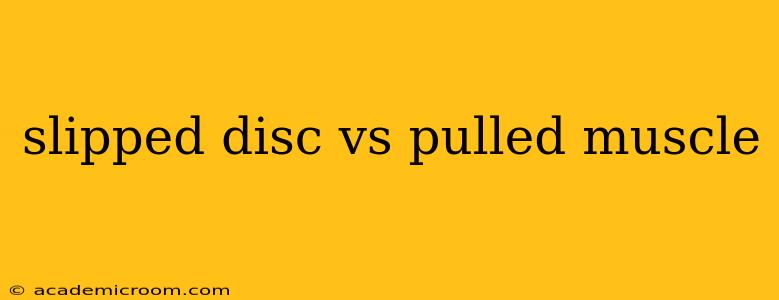Back pain is a common ailment, often leaving sufferers wondering if their discomfort stems from a slipped disc or a pulled muscle. While both conditions cause significant pain and discomfort, understanding their key differences is crucial for appropriate treatment and recovery. This article will delve into the nuances of each condition, helping you better understand your symptoms and seek the right medical advice.
What is a Slipped Disc?
A slipped disc, more accurately termed a herniated disc, occurs when the soft, gel-like center of an intervertebral disc pushes through a tear in the tough outer layer. These discs act as cushions between the vertebrae in your spine. When one herniates, it can press on nearby nerves, causing pain, numbness, tingling, and weakness that often radiates down the leg (sciatica) or arm. The location of the herniation dictates the specific symptoms experienced. It's important to note that not all herniated discs cause symptoms; many go unnoticed.
What causes a slipped disc?
Several factors contribute to slipped discs, including:
- Age: As we age, the discs naturally degenerate, becoming more prone to tears and herniation.
- Injury: Sudden trauma, such as a fall or impact, can cause immediate disc herniation.
- Repetitive stress: Repeated lifting, bending, or twisting motions can gradually weaken the discs, increasing the risk of herniation.
- Poor posture: Maintaining poor posture puts added strain on the spine and discs.
- Obesity: Excess weight places increased pressure on the spine, accelerating disc degeneration.
What is a Pulled Muscle?
A pulled muscle, or muscle strain, is an injury to a muscle or tendon resulting from overuse, overstretching, or tearing of muscle fibers. This commonly affects the back muscles, often causing localized pain and stiffness. The severity of a pulled muscle can vary, ranging from mild discomfort to debilitating pain.
What causes a pulled muscle?
Several factors can lead to a pulled muscle in the back, including:
- Sudden movements: Lifting heavy objects incorrectly, twisting suddenly, or engaging in strenuous activity without proper warm-up can strain back muscles.
- Overuse: Repetitive movements or prolonged periods of physical activity can fatigue the muscles, making them more susceptible to injury.
- Poor physical conditioning: Weak or inflexible muscles are more prone to strain.
- Improper posture: Poor posture weakens the muscles supporting the spine, increasing the likelihood of injury.
- Dehydration: Dehydrated muscles are more prone to injury.
Slipped Disc vs. Pulled Muscle: Key Differences
| Feature | Slipped Disc | Pulled Muscle |
|---|---|---|
| Cause | Disc herniation | Muscle or tendon strain |
| Pain Location | Localized, often radiating down the leg/arm | Localized to the affected muscle/tendon |
| Symptoms | Pain, numbness, tingling, weakness, sciatica | Pain, stiffness, muscle spasms, limited ROM |
| Onset | Can be sudden or gradual | Usually sudden, after exertion |
| Diagnosis | MRI, CT scan, physical exam | Physical exam, sometimes imaging |
| Treatment | Rest, medication, physical therapy, surgery (in severe cases) | Rest, ice, heat, pain relievers, stretching, physical therapy |
How are Slipped Discs and Pulled Muscles Diagnosed?
Diagnosing a slipped disc often requires imaging studies like an MRI or CT scan to visualize the herniated disc. A physical examination helps assess neurological symptoms, such as weakness or numbness. Diagnosing a pulled muscle typically involves a thorough physical examination, where the doctor assesses muscle tenderness, range of motion, and strength. Imaging studies are less frequently needed for pulled muscles unless there's suspicion of a more serious injury.
What are the Treatments for a Slipped Disc and Pulled Muscle?
Treatment for both conditions often involves conservative measures initially. These include:
- Rest: Avoiding activities that aggravate pain is crucial.
- Pain relief: Over-the-counter pain relievers (NSAIDs) or prescription medication may be necessary.
- Physical therapy: Exercises to strengthen core muscles, improve posture, and restore mobility are often beneficial.
For severe cases of slipped discs, surgery may be considered. Pulled muscles usually respond well to conservative treatment, with recovery typically occurring within a few weeks.
Can a Pulled Muscle Mimic a Slipped Disc?
Yes, the symptoms of a severe pulled muscle can sometimes overlap with those of a mild slipped disc, making differentiation challenging. The radiating pain, numbness, and tingling associated with a herniated disc are not always present, and a pulled muscle can cause significant pain and discomfort. This is why it's crucial to seek professional medical advice for accurate diagnosis.
When Should I See a Doctor?
Consult a doctor if:
- Your pain is severe or persistent.
- You experience numbness, tingling, or weakness in your limbs.
- Your pain is accompanied by fever or bowel/bladder dysfunction.
- You experience significant limitations in your daily activities.
By understanding the key differences between a slipped disc and a pulled muscle, you can better advocate for your health and receive appropriate treatment. Remember, this information is for educational purposes only and should not replace professional medical advice. Always consult a healthcare provider for diagnosis and treatment of any medical condition.
